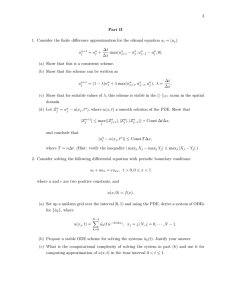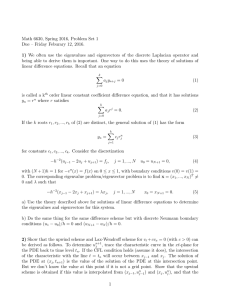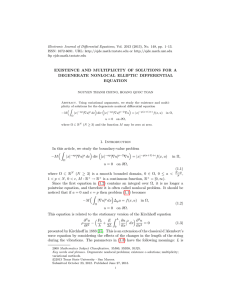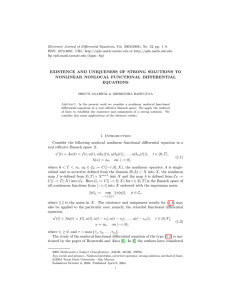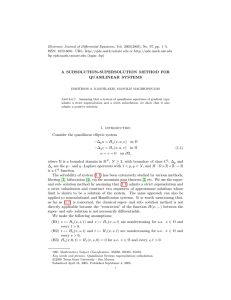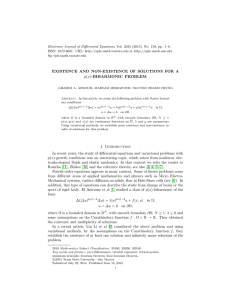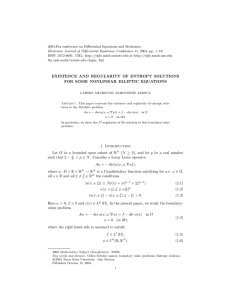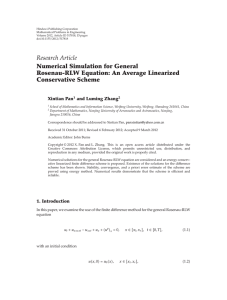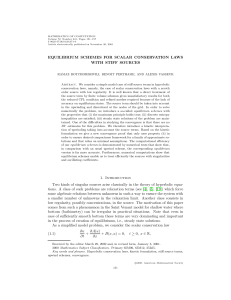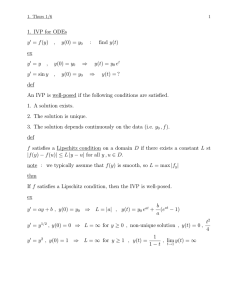2005-Oujda International Conference on Nonlinear Analysis.
advertisement
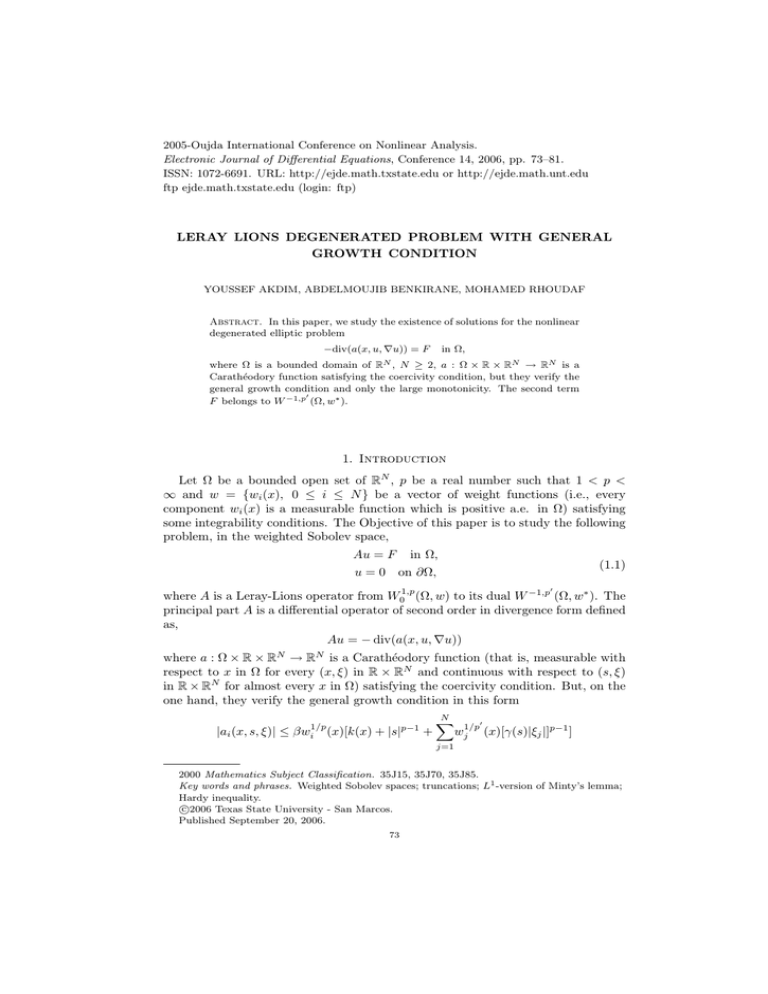
2005-Oujda International Conference on Nonlinear Analysis.
Electronic Journal of Differential Equations, Conference 14, 2006, pp. 73–81.
ISSN: 1072-6691. URL: http://ejde.math.txstate.edu or http://ejde.math.unt.edu
ftp ejde.math.txstate.edu (login: ftp)
LERAY LIONS DEGENERATED PROBLEM WITH GENERAL
GROWTH CONDITION
YOUSSEF AKDIM, ABDELMOUJIB BENKIRANE, MOHAMED RHOUDAF
Abstract. In this paper, we study the existence of solutions for the nonlinear
degenerated elliptic problem
−div(a(x, u, ∇u)) = F
in Ω,
where Ω is a bounded domain of RN , N ≥ 2, a : Ω × R × RN → RN is a
Carathéodory function satisfying the coercivity condition, but they verify the
general growth condition and only the large monotonicity. The second term
0
F belongs to W −1,p (Ω, w∗ ).
1. Introduction
Let Ω be a bounded open set of RN , p be a real number such that 1 < p <
∞ and w = {wi (x), 0 ≤ i ≤ N } be a vector of weight functions (i.e., every
component wi (x) is a measurable function which is positive a.e. in Ω) satisfying
some integrability conditions. The Objective of this paper is to study the following
problem, in the weighted Sobolev space,
Au = F
u=0
in Ω,
(1.1)
on ∂Ω,
0
where A is a Leray-Lions operator from W01,p (Ω, w) to its dual W −1,p (Ω, w∗ ). The
principal part A is a differential operator of second order in divergence form defined
as,
Au = − div(a(x, u, ∇u))
where a : Ω × R × RN → RN is a Carathéodory function (that is, measurable with
respect to x in Ω for every (x, ξ) in R × RN and continuous with respect to (s, ξ)
in R × RN for almost every x in Ω) satisfying the coercivity condition. But, on the
one hand, they verify the general growth condition in this form
1/p
|ai (x, s, ξ)| ≤ βwi
(x)[k(x) + |s|p−1 +
N
X
1/p0
wj
(x)[γ(s)|ξj |]p−1 ]
j=1
2000 Mathematics Subject Classification. 35J15, 35J70, 35J85.
Key words and phrases. Weighted Sobolev spaces; truncations; L1 -version of Minty’s lemma;
Hardy inequality.
c
2006
Texas State University - San Marcos.
Published September 20, 2006.
73
74
Y. AKDIM, A. BENKIRANE, M. RHOUDAF
EJDE/CONF/14
instead the classical growth condition, where we introduce some continuous function
γ(s). This type of the growth condition can not guaranteed the existence of the
weak solution (See Remark 4.6), for that we overcame this difficulty by introduce
an other type of solution so-called T-solution. On the other hand, they verify only
the large monotonicity, that is
[a(x, s, ξ) − a(x, s, η)](ξ − η) ≥ 0
for all (ξ, η) ∈ RN × RN .
We overcome this difficulty of the not strict monotonicity thanks to a technique
(the L1 -version of Minty’s lemma) similar to the one used in [5]. Recently in [6]
Boccardo has studied the problem (1.1) in the classical Sobolev space W01,p (Ω).
For that the author has proved the existence of the T-solution. Other works in this
0
direction can be found in [5] (where the right hand side f ∈ L1 and F ∈ Lp (Ω))
and in [1] (where the existence and nonexistence results for some quasilinear elliptic
equations involving the P-Laplaces have proved).
2. Preliminaries
Let Ω be a bounded open set of RN , p be a real number such that 1 < p < ∞
and w = {wi (x), 0 ≤ i ≤ N } be a vector of weight functions, i.e., every component
wi (x) is a measurable function which is strictly positive a.e. in Ω. Further, we
suppose in all our considerations that (for each wi 6= 0.)
wi ∈ L1loc (Ω),
−1
p−1
wi
∈ L1loc (Ω),
(2.1)
(2.2)
for any 0 ≤ i ≤ N .
We denote by W 1,p (Ω, w) the space of all real-valued functions u ∈ Lp (Ω, w0 )
such that the derivatives in the sense of distributions fulfill
∂u
∈ Lp (Ω, wi ) for i = 1, . . . , N.
∂xi
Which is a Banach space under the norm
N Z
hZ
i1/p
X
∂u(x) p
p
kuk1,p,w =
|u(x)| w0 (x) dx +
|
| wi (x) dx
.
∂xi
Ω
i=1 Ω
(2.3)
The condition (2.1) implies that C0∞ (Ω) is a space of W 1,p (Ω, w) and consequently,
we can introduce the subspace W01,p (Ω, w) of W 1,p (Ω, w) as the closure of C0∞ (Ω)
with respect to the norm (2.3). Moreover, condition (2.2) implies that W 1,p (Ω, w)
as well as W01,p (Ω, w) are reflexive Banach spaces.
We recall that the dual space of weighted Sobolev spaces W01,p (Ω, w) is equivalent
0
0
to W −1,p (Ω, w∗ ), where w∗ = {wi∗ = wi1−p , i = 0, . . . , N } and where p0 is the
p
.
conjugate of p i.e. p0 = p−1
3. Basic assumptions and statement of results
Assumption (H1). The expression
N Z
X
1/p
∂u(x) p
k|u|kX =
|
| wi (x) dx
∂xi
i=1 Ω
(3.1)
EJDE/CONF/14
LERAY LIONS DEGENERATED PROBLEM
75
is a norm defined on X and is equivalent to the norm (2.3).
There exist a weight function σ on Ω and a parameter q, 1 < q < ∞, such that the
Hardy inequality,
N Z
Z
1/q
X
1/p
∂u(x) p
q
|u(x)| σ dx
≤c
| wi (x) dx
,
(3.2)
|
∂xi
Ω
i=1 Ω
holds for every u ∈ X with a constant c > 0 independent of u, and moreover, the
imbedding
X ,→,→ Lq (Ω, σ),
(3.3)
expressed by the inequality (3.2) is compact.
Note that (X, k|.|kX ) is a uniformly convex (and thus reflexive) Banach space.
Remark 3.1. If we assume that w0 (x) ≡ 1 and in addition the integrability con1
dition: There exists ν ∈] N
P , +∞ [∩[ P −1 , +∞[ such that
wi−ν ∈ L1 (Ω)
for all i = 1, . . . , N.
Note that the assumptions (2.1) and (3.4) imply that,
N Z
X
1/p
∂u p
|
k|uk| =
,
| wi (x) dx
∂xi
i=1 Ω
(3.4)
(3.5)
is a norm defined on W01,p (Ω, w) and its equivalent to (2.3) and that, the imbedding
W01,p (Ω, w) ,→ Lp (Ω),
(3.6)
is compact for all 1 ≤ q ≤ p∗1 if p.ν < N (ν + 1) and for all q ≥ 1 if p.ν ≥ N (ν + 1)
pν
where p1 = ν+1
and p∗1 is the Sobolev conjugate of p1 [see [9], pp 30-31].
Assumption (H2).
1/p
|ai (x, s, ξ)| ≤ βwi
(x)[k(x) + |s|p−1 +
N
X
1/p0
(x)[γ(s)|ξj |]p−1 ],
(3.7)
for all (ξ, η) ∈ RN × RN ,
(3.8)
wj
j=1
[a(x, s, ξ) − a(x, s, η)](ξ − η) ≥ 0
a(x, s, ξ).ξ ≥ α
N
X
wi |ξi |p ,
(3.9)
i=1
0
where k(x) is a positive function in Lp (Ω),
are strictly positive constants.
We recall that, for k > 1 and s in R, the
(
s
Tk (s) =
s
k |s|
γ(s) is a continuous function and α, β
truncation is defined as,
if s ≤ k
if |s| > k.
4. Existence results
Consider the problem
u ∈ W01,p (Ω, w),
0
F ∈ W −1,p (Ω, w∗ )
− div(a(x, u, ∇u)) = F
u = 0 on ∂Ω.
in Ω
(4.1)
76
Y. AKDIM, A. BENKIRANE, M. RHOUDAF
EJDE/CONF/14
Definition 4.1. A function u in W01,p (Ω, w) is a T -solution of (4.1) if
Z
a(x, u, ∇u)∇Tk [u − ϕ] dx = hF, Tk [u − ϕ]i ∀ϕ ∈ W01,p (Ω, w) ∩ L∞ (Ω).
Ω
Theorem 4.2. Assume that (H1) and(H2). Then the problem (4.1) has at least
one T -solution u.
Remark 4.3. Recall that an existence result for the problem (4.1) can be found
in [8] by using the approach of pseudo monotonicity with some particular growths
condition, that is γ(s) = 1.
Remark 4.4. In [9] the authors study the problem (4.1) under the strong hypotheses
[a(x, s, ξ) − a(x, s, η)](ξ − η) > 0,
1/p
|ai (x, s, ξ)| ≤ βwi
for all ξ 6= η ∈ RN ,
(x)[k(x) + |s|p−1 +
N
X
1/p0
wj
(x)|ξj |p−1 ],
j=1
instead of (3.8) and (3.7) (respectively ). Then the operator A associated to the
problem (4.1) verifies the (S + ) condition and is coercive. Hence A is surjective
0
from W01,p (Ω, w) into its dual W −1,p (Ω, w∗ ).
Proof of Theorem 4.2. Consider the approximate problem
un ∈ W01,p (Ω, w)
− div(a(x, Tn (un ), ∇un )) = F.
(4.2)
under the following assumptions:
Assertion (a): A priori estimates The problem (4.2) has a solution by a classical
result in [8]. Moreover, by using un as test function in (4.2) we have,
Z
Z
a(x, Tn (un ), ∇un ).∇un dx =
F un dx.
Ω
Ω
Thanks to assumption (3.9), we have
Z
N Z
X
∂un p
| wi (x) dx = αk|un k|p
|
a(x, Tn (un ), ∇un ).∇un dx ≥ α
∂x
i
Ω
i=1 Ω
i.e.,
αk|un k|p ≤ hF, un i ≤ kF k−1,p0 ,w∗ k|un k|,
which implies αk|un k|p ≤ C1 k|un k| for p > 1, with C1 is a constant positive,
then the sequence un is bounded in W01,p (Ω, w), thus, there exists a function
u ∈ W01,p (Ω, w) and a subsequence unj such that unj converges weakly to u in
W01,p (Ω, w).
Assertion (b) We shall prove that for ϕ in W01,p (Ω, w) ∩ L∞ (Ω), we have
Z
a(x, unj , ∇ϕ)∇Tk [unj − ϕ] dx ≤ hF, Tk [unj − ϕ]i.
(4.3)
Ω
Let nj large enough (nj > k + kϕkL∞ (Ω) ), we have by choosing Tk [unj − ϕ] as test
function in (4.2)
Z
a(x, unj , ∇unj )∇Tk [unj − ϕ] dx = hF, Tk [unj − ϕ]i,
Ω
EJDE/CONF/14
LERAY LIONS DEGENERATED PROBLEM
77
i.e.,
Z
Z
a(x, unj , ∇unj )∇Tk [unj − ϕ] dx +
Z
−
a(x, unj , ∇ϕ)∇Tk [unj − ϕ] dx
a(x, unj , ∇ϕ)∇Tk [unj − ϕ] dx
Ω
Ω
Ω
= hF, Tk [unj − ϕ]i,
which implies
Z
[a(x, unj , ∇unj ) − a(x, unj , ∇ϕ)]∇Tk [unj − ϕ] dx
Ω
Z
+
a(x, unj , ∇ϕ)∇Tk [unj − ϕ] dx = hF, Tk [unj − ϕ]i.
(4.4)
Ω
Thanks to assumption (3.8) and the definition of truncating function, we have,
Z
[a(x, unj , ∇unj ) − a(x, unj , ∇ϕ)]∇Tk [unj − ϕ] dx ≥ 0.
(4.5)
Ω
Combining (4.4) and (4.5), we obtain (4.3).
Assertion (c) We claim that,
Z
Z
a(x, unj , ∇ϕ)∇Tk [unj − ϕ] dx →
a(x, u, ∇ϕ)∇Tk [u − ϕ] dx
Ω
Ω
and that
hF, Tk [unj − ϕ]i → hF, Tk [u − ϕ]i.
Indeed, first, by virtue of unj * u weakly in W01,p (Ω, w), and [3, Lemma 2.4], we
have
Tk (unj − ϕ) * Tk (u − ϕ) in W01.p (Ω, w).
(4.6)
Which gives
∂Tk
∂Tk
(unj − ϕ) *
(unj − ϕ) in Lp (Ω, wi ).
(4.7)
∂xi
∂xi
Note that ∇Tk (unj − ϕ) is not zero on the subset {x ∈ Ω : |unj − ϕ(x)| ≤ k} (subset
of {x ∈ Ω : |unj (x)| ≤ k + kϕkL∞ (Ω) },). Thus thanks to assumption (3.7), we have
0
−p0 /p
|ai (x, unj , ∇ϕ)|p wi
≤ [k(x) + |unj |p−1 + γ0p−1
N
X
∂ϕ p−1 1/p0 p0
|
| wk ]
∂xk
k=1
p0
p
≤ β[k(x) + |unj | +
γ0p
N
X
k=1
(4.8)
∂ϕ p
| wk ].
|
∂xk
where {γ0 = sup|γ(s)|, |s| ≤ k + kϕk∞ }. Since unj * u weakly in W01,p (Ω, w)
and W01,p (Ω, w) ,→,→ Lq (Ω, σ), it follows that unj → u strongly in Lq (Ω, σ) and
unj → u a.e. in Ω. Combining (4.7), (4.8) and By Vitali’s theorem we obtain,
Z
Z
a(x, unj , ∇ϕ)∇Tk [unj − ϕ] dx →
a(x, u, ∇ϕ)∇Tk [u − ϕ] dx.
(4.9)
Ω
Ω
Secondly, we show that
hF, Tk [unj − ϕ]i → hF, Tk [u − ϕ]i.
(4.10)
78
Y. AKDIM, A. BENKIRANE, M. RHOUDAF
EJDE/CONF/14
0
In view of (4.6) and since F ∈ W −1,p (Ω, w∗ ), we get
hF, Tk [unj − ϕ]i → hF, Tk [u − ϕ]i.
(4.11)
The convergence (4.9) and (4.11) allow to pass to the limit in the inequality (4.3),
and to obtain
Z
a(x, u, ∇ϕ)∇Tk [u − ϕ] dx ≤ hF, Tk [u − ϕ]i.
(4.12)
Ω
Now we introduce the following Lemma which will be proved later and which is
considered as an L1 version of Minty’s lemma (in weighted Sbolev spaces).
Result (4.12) and the following lemma complete the proof of Theorem 4.2. Lemma 4.5. Let u be a measurable function such that Tk (u) belongs to W01,p (Ω, w)
for every k > 0. Then the following two statements are equivalent:
(i) For every ϕ in W01,p (Ω, w) ∩ L∞ (Ω) and every k > 0,
Z
Z
a(x, u, ∇ϕ)∇Tk [u − ϕ] dx ≤
F ∇Tk (u − ϕ) dx .
Ω
Ω
W01,p (Ω, w)
∞
(ii) For every ϕ in
∩ L (Ω) and every k > 0,
Z
Z
a(x, u, ∇u)∇Tk [u − ϕ] dx =
F ∇Tk (u − ϕ) dx .
Ω
Ω
Proof. Note that (ii) implies (i) is easily proved adding and subtracting
Z
a(x, u, ∇ϕ)∇Tk [u − ϕ] dx,
Ω
and then using assumption (3.8). Thus, it only remains to prove that (i) implies (ii).
Let h and k be positive real numbers, let λ ∈] − 1, 1[ and ψ ∈ W01,p (Ω, w) ∩ L∞ (Ω).
Choosing, ϕ = Th (u − λTk (u − ψ)) ∈ W01,p (Ω, w) ∩ L∞ (Ω) as test function in (4.12),
we have,
I ≤ J,
(4.13)
with
Z
a(x, u, ∇Th (u − λTk (u − ψ))∇Tk (u − Th (u − λTk (u − ψ)) dx,
I=
Ω
J = hF, Tk (u − Th (u − λTk (u − ψ))i.
Put Ahk = {x ∈ Ω : |u − Th (u − λTk (u − ψ))| ≤ k} and Bh = {x ∈ Ω : |u − λTk (u −
ψ)| ≤ h}. Then, we have
Z
I=
a(x, u, ∇Th (u − λTk (u − ψ))∇Tk (u − Th (u − λTk (u − ψ)) dx
Akh ∩Bh
Z
+
a(x, u, ∇Th (u − λTk (u − ψ))∇Tk (u − Th (u − λTk (u − ψ)) dx
C
Akh ∩Bh
Z
a(x, u, ∇Th (u − λTk (u − ψ))∇Tk (u − Th (u − λTk (u − ψ))) dx.
+
AC
kh
Since ∇Tk (u − Th (u − λTk (u − ψ)) is zero in AC
kh , we obtain
Z
a(x, u, ∇Th (u − λTk (u − ψ))∇Tk (u − Th (u − λTk (u − ψ)) dx = 0.
AC
kh
(4.14)
EJDE/CONF/14
LERAY LIONS DEGENERATED PROBLEM
79
Moreover, if x ∈ BhC , we have ∇Th (u − λTk (u − ψ) = 0 which implies,
Z
a(x, u, ∇Th (u − λTk (u − ψ))∇Tk (u − Th (u − λTk (u − ψ)) dx
C
Akh ∩Bh
Z
a(x, u, 0)∇Tk (u − Th (u − λTk (u − ψ)) dx.
=
C
Akh ∩Bh
Now, thanks to assumption (3.9), we have a(x, u, 0) = 0. Then
Z
a(x, u, 0)∇Tk (u − Th (u − λTk (u − ψ)) dx = 0.
(4.15)
Akh ∩Bh
Combining (4.14) and (4.15), we obtain
Z
I=
a(x, u, ∇Th (u − λTk (u − ψ))∇Tk (u − Th (u − λTk (u − ψ)) dx,
Akh ∩Bh
letting h → +∞, we have
Akh → {x, |Tk (u − ψ)| ≤ k} = Ω,
(4.16)
and Bh → Ω which implies
Akh ∩ Bh → Ω.
(4.17)
Then
Z
lim
a(x, u, ∇Th (u − λTk (u − ψ))∇Tk (u − Th (u − λTk (u − ψ)) dx
h→+∞ A ∩B
kh
h
Z
=λ
a(x, u, ∇(u − λTk (u − ψ)∇Tk (u − ψ) dx.
Ω
(4.18)
On the other hand, we have
J = hF, Tk [u − Th (u − λTk (u − ψ)]i.
Then
lim hF, Tk (u − Th (u − λTk (u − ψ))i = λhF, Tk [u − ψ]i.
h→+∞
(4.19)
Together (4.18), (4.19) and passing to the limit in (4.13), we obtain
Z
λ
a(x, u, ∇(u − λTk (u − ψ)∇Tk (u − ψ) dx ≤ λhF, Tk [u − ψ]i
Ω
for every ψ ∈ W01,p (Ω, w) ∩ L∞ (Ω), and for k > 0. Choosing λ > 0 dividing by λ,
and then letting λ tend to zero , we obtain
Z
a(x, u, ∇u)∇Tk (u − ψ) dx ≤ hF, Tk [u − ψ]i.
(4.20)
Ω
For λ < 0 , dividing by λ, and then letting λ tend to zero , we obtain
Z
a(x, u, ∇u)∇Tk (u − ψ) dx ≥ hF, Tk [u − ψ]i,
(4.21)
Ω
Combining (4.20) and (4.21), we conclude that
Z
a(x, u, ∇u)∇Tk (u − ψ) dx = hF, Tk [u − ψ]i.
Ω
This completes the proof of Lemma.
80
Y. AKDIM, A. BENKIRANE, M. RHOUDAF
EJDE/CONF/14
Remark 4.6. (1) The fact that the terms Tn (un ) is introduced in (4.2) and also
γ(s) is a continuous function, allow to have a weak solution for the a approximate
problem.
(2) Since in the formulation of the problem (4.1), we have a(x, u, ∇u) instead of
0
a(x, Tn (un ), ∇un ), then the term a(x, u, ∇u) may not belongs in Lp (Ω, w∗ ) and not
1
in L (Ω), thus the problem (4.1) can have a T-solutions but, not a weak solution.
For example if wi ≡ 1, i = 1, . . . , N and a(x, u, ∇u) = e|u| |∇u|p−2 ∇u, with
γ(s) = e|s| then
0
u ∈ W01,p (Ω, w), F ∈ W −1,p (Ω, w∗ )
− div(e|u| |∇u|p−2 ∇u) = F
in Ω
u = 0 on ∂Ω.
our simple problem has a T -solutions, but not a weak solution
Example 4.7. Let us consider the special case:
ai (x, η, ξ) = e|s| wi (x)|ξi |p−1 sgn(ξi ) i = 1, . . . , N,
with wi (x) is a weight function (i = 1, . . . , N ). For simplicity, we shall suppose
that wi (x) = w(x), for i = 1, . . . , N − 1, and wN (x) ≡ 0 it is easy to show that the
ai (x, s, ξ) are Caracthéodory function satisfying the growth condition (3.7) and the
coercivity (3.8). On the other hand the monotonicity condition is verified. In fact,
N
X
ˆ i − ξˆi )
(ai (x, s, ξ) − ai (x, s, ξ))(ξ
i=1
= e|s| w(x)
N
−1
X
(|ξi |p−1 sgn(ξi ) − |ξˆi |p−1 sgn(ξˆi ))(ξi − ξˆi ) ≥ 0
i=1
for almost all x ∈ Ω and for all ξ, ξˆ ∈ RN . This last inequality can not be strict,
since for ξ 6= ξˆ with ξN 6= ξˆN and ξi = ξˆi , i = 1, . . . , N − 1. The corresponding
expression is zero. In particular, let us use special weight functions w expressed
in terms of the distance to the bounded ∂Ω. Denote d(x) = dist(x, ∂Ω) and set
w(x) = dλ (x), such that,
p
λ < min( , p − 1)
(4.22)
N
Remark 4.8. Condition (4.22) is sufficient for (3.4) to hold [see [10],pp 40-41].
Finally, the hypotheses of Theorem 4.2 are satisfied. Therefore, for all F ∈
QN p0
∗
i=1 L (Ω, wi ) the following problem has at last one solution:
Tk (u) ∈ W01,p (Ω, w),
Z X
N
Ω i=1
wi (x)e|u| |
∂u p−1
∂u ∂Tk (u − ϕ)
|
sgn
dx =
∂xi
∂xi
∂xi
Z
F Tk (u − ϕ) dx
Ω
∀ϕ ∈ W01,p (Ω, w) ∩ L∞ (Ω) .
References
[1] B. Abdellaou and I. Peral, Existence and nonexistence results for quasilinear elliptic equations
involving, The P-Laplaces, Ann. Mat. Pure Applicata vol 182 (2003) 247-270.
[2] R. Adams, Sobolev spaces, AC, Press, New York, 1975.
EJDE/CONF/14
LERAY LIONS DEGENERATED PROBLEM
81
[3] Y. Akdim, E. Azroul, and A. Benkirane, Existence of Solution for quasilinear degenerated
Elliptic Unilateral Problems, Ann. Math. Blaise pascal vol 10 (2003) pp 1-20.
[4] Y. Akdim, E. Azroul and A. Benkirane, Existence of solution for quasilinear degenerated
elliptic equation, Electronic J. Diff. Equ. Vol 2001 , No 71 (2001), pp 1-19.
[5] L. Boccardo, L. Orsina, Existence Results for Dirichlet Problem in L1 via Minty’s lemma,
Applicable Ana. (1999) pp 309-313.
[6] L. Boccardo, A remark on some nonlinear elliptic problems, Electronic J. Diff. Equ. Conference 08, (2002) pp 47-52.
[7] L. Boccardo T. Gallouet, Nonlinear elliptic equations with right hand side measure, Comm.
Partial Differential Equations, 17 (1992), 641-169.
[8] P. Drabek, A. Kufner and V. Mustonen, Pseudo-monotonicity and degenerated or singular
elliptic operators, Bull. Austral. Math. Soc. Vol. 58 (1998), 213-221.
[9] P. Drabek, A. Kufner and F. Nicolosi, Non linear elliptic equations, singular and degenerated
cases, University of West Bohemia, (1996).
[10] A. Kufner, Weighted Sobolev Spaces, John Wiley and Sons, (1985).
[11] J. L. Lions quelques méthodes de résolution des problème aux limites non lineaires, Dundo,
Paris (1969).
Youssef Akdim
Département de Mathématiques et Informatique, Faculté des Sciences Dhar-Mahraz,
B.P 1796 Atlas Fès, Maroc
E-mail address: akdimyoussef@yahoo.fr
Abdelmoujib Benkirane
Département de Mathématiques et Informatique, Faculté des Sciences Dhar-Mahraz,
B.P 1796 Atlas Fès, Maroc
E-mail address: abenkirane@fsdmfes.ac.ma
Mohamed Rhoudaf
Département de Mathématiques et Informatique, Faculté des Sciences Dhar-Mahraz,
B.P 1796 Atlas Fès, Maroc
E-mail address: rhoudaf mohamed@yahoo.fr
